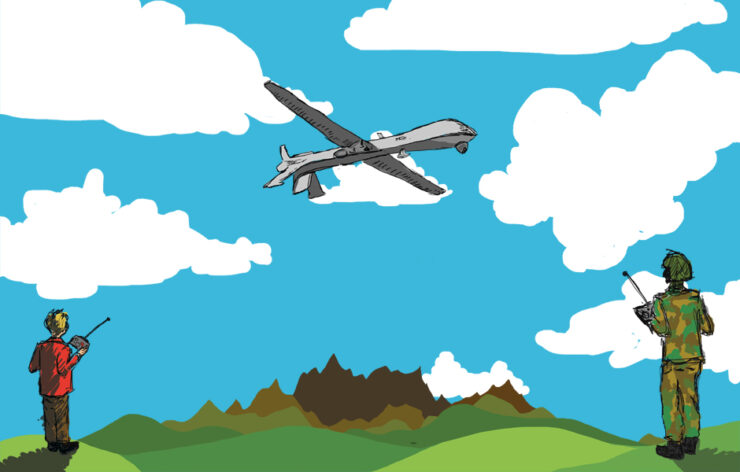
Why the potential benefits of commercial and recreational drones are flying over our heads
Illustration by Adam Gibbard
Dippin’ Dots. Microwaves. Menstrual pads. The Internet. GPS. Cargo pants.
Some of the wonders of modern life—and an unflattering fashion trend of the late ‘90s—all started as military innovation and were later adapted for commercial and recreational use.
For technological innovators working with the military, making their creations commercially viable is the ultimate success. While the military pays for development, adaptations from commercialization mean the product can be made more cheaply and quickly, and distributed more widely, all without that nasty association with death and violence. The military in turn benefits from the lower cost of commercial adaptations and is more likely to fund the innovators’ next projects. Everybody wins.
Unless you can’t quite get past that affiliation with war.
This is one of the problems facing commercial and recreational drones.
The drone market
According to Clay Dillow of Fortune, the global market for non-military drones has skyrocketed into a $2.5-billion industry, with 15 to 20 per cent annual growth. The numbers are all the more impressive when you consider that current laws and regulatory hurdles in the United States and Canada have prevented non-military drones from reaching their full potential. Some of these regulations stem from the association we have between unmanned aerial vehicles and drone strikes.
Not that the association is unfounded. Drones were first used by the American military and the CIA for targeted killing after Sept. 11, 2001, and by 2012 more than 20,000 drones were being used in conflicts around the world.
In 2013, the Pew Research Center found that 61 per cent of Americans and 43 per cent of Canadians support the use of drones against terrorists abroad. Meanwhile, 63 per cent of Americans are opposed to personal and commercial drones being allowed to fly through U.S. airspace.
“The first reaction from people to drones is always emotional,” said Jonathan Ledgard, director of AfroTech, an initiative to help pioneer advanced technologies in Africa, in an interview with NPR.
Ledgard believes drones can help build trade in Africa by providing easy transport solutions in areas where very little infrastructure is in place.
“We need to develop them in a way that humans don’t feel threatened,” he said.
Another roadblock for drones is airspace. Air traffic control is responsible for ensuring that each aircraft has a minimum amount of space around it to prevent collision. In order to facilitate this, air traffic controllers need to know the locations of all aircraft within their airspace.
While most recreational and commercial drones aren’t powerful enough to get in the way of planes, as the technology develops there are concerns that they could cause collisions. Air traffic controllers already have a difficult job regulating aircrafts without adding potential delivery drone interference on top of that.
The United States has been hesitant to allow commercial or recreational drone use at all. Currently, the commercial use of drones is banned in the U.S. unless a company gets an exemption, and thus far the U.S. Federal Aviation Administration (FAA) has granted exemptions to just 24 of 342 applicants for the commercial use of drones.
Delivering the future
In Canada the rules are more lenient. Any person or company looking to operate a drone for commercial purposes must apply for a Special Flight Operations Certificate (SFOC) through Transport Canada. Operators are required to list the times, dates and areas in which their drones will fly. SFOCs also contain safety regulations regarding line-of-sight and flying distances over populated areas. In 2014, Transport Canada issued 1,672 SFOCs.
An SFOC is essential for any company looking to incorporate drone technology into its business model.
Amazon has been trying to use drones for their rapid delivery service, Amazon Prime, but have been unable to get approval from the U.S. government to test their project. On March 30, the Globe and Mail reported that Amazon is “rapidly experimenting” with unmanned aircrafts in Chilliwack, B.C., after the company received an SFOC to test the new delivery service, which would use low-flying drones to deliver small packages in the U.S., U.K., and Israel.
Brendan Schulman, a New York-based lawyer and drone expert, told the Globe and Mail that the FAA has already announced new draft rules for commercial drones that would make it easier for companies like Amazon to gain approval, but the regulations could take two years to come into effect and could still force pilots to maintain eyesight with each drone—making Amazon’s plan highly improbable anytime soon.
Alan Gardner is a University of Ottawa computer engineering alumnus and a local recreational drone user. He founded Ottawa Drones, a group of programmers who meet to develop software for unmanned aerial vehicles called quadcopters. He says he’s not very optimistic about delivery projects like Amazon’s.
“I actually am not terribly bullish on the value of drones commercially,” he said. “The problem that I see for these delivery ones is that when everyone wants drone delivery, it’s going to get terribly complicated and then when things go wrong, they fall out of the sky and hit you in the head.”
Gardner says the technology simply isn’t good enough yet. Most of the models available for commercial and recreational use have a limited range and battery life. Amazon will have to prove their drones have much higher reliability than anything currently on the market.
This unreliability is present in military drone use as well. The machines are meant to target individuals yet they don’t seem to be very good at it. The technology is more precise than a bombing or a rocket, but too often we hear of drone strikes leaving hundreds of innocents dead as collateral damage.
According to the Bureau of Investigative Journalism, between 2004 and 2015, U.S.-led drone strikes in Pakistan alone have killed nearly 1,000 civilians, including more than 200 children. This is a relatively small number compared to a military practice like carpet bombing, but for a method that’s meant to be precise, it suggests a rather large margin for error.
This problem is compounded by a lack of responsibility. While someone somewhere is remotely controlling a military drone, they aren’t physically present for the act of violence. The secrecy of the U.S. military’s drone strikes further compounds this—it is unclear who is responsible for the deaths.
Regulating responsibility
Some warn that recreational drones provide a component of secrecy that may soon result in a privacy issue in Canada. An article by Maclean’s stated that drones weighing less than 35 kilograms do not require a SFOC, and thus are unregulated by Canadian law. The Canadian privacy commissioner’s office has published a new study that says these smaller recreational drones are problematic because they could make it easier for people to use drone technology to survey fellow citizens. It’s a problem that could become large-scale as companies have begun selling small, inexpensive drones than can stream live video to smartphones.
The problem of responsibility in commercial use, like delivery service, may seem to have lower stakes than a drone strike, but if drones are falling out of the sky and potentially injuring people or causing traffic accidents, accountability for their actions becomes difficult to delegate.
Kristen Thomasen, currently working on her doctorate on the regulation of domestic drones at the University of Ottawa’s Centre for Technology, Law and Society, wrote in an article contributed to the Globe and Mail that the Canadian government needs to build a better regulatory architecture to ensure drones are used safely and accountably in the future.
“Licencing requirements can ensure skilled pilots, performance standards requirements can ensure properly built drones, flying parameters will help manage air traffic and protect the serenity of certain public spaces, and criminal laws can prohibit and punish for the more nefarious surveillance or armed uses of drones,” she said.
“And perhaps more significantly, through collaboration with innovators, governments might be able to control the ability of drones to carry certain objects, transmit personal information, verify their owners’ identities, or fly in certain locations, by design. Laws that set out design requirements, like the ones we use for cars, can help mitigate the harms caused by drones without relying on users to fly them correctly.”
Perhaps in the coming months and years Amazon or other companies will be able to create a product that can meet a basic standard of reliability, and it will revolutionize commercial drone use. For now, drones have many applications beyond military drone strikes that are only starting to come into use.
Drones are beginning to be used to track and manage animal populations so scientists can see where the animals are going, observe and prevent poaching, and monitor habitat loss. Drones with sensors can scan homes for leaks and structural damage. Some have begun taking photos of crime scenes and traffic accidents for the RCMP. Others film TV shows and movies from new angles. Some are even being sold as toys.
Gardner says he doesn’t agree that a military association in the minds of the public is holding back regulation. He says, “Even though we use the same terminology, there’s very little in common between the one that I’ve got and like a Predator that’s flying over Yemen.”
But until more of the public sees unmanned aerial vehicles in the public sphere, military drones are still the first thing most people think of in relation to the technology. And some of the concerns raised by that association are legitimate. If the technology isn’t reliable and operators can’t be held accountable, drones don’t have to be killing anyone to be problematic.
However, like any military technology that ends up in recreational and commercial spheres, it will take development to get to a level where people can trust drones to fly over their heads safely. And development is only possible through repeated tests, not by making the technology illegal.
“On the one hand, the FAA wants to see that this technology is safe, but they don’t allow companies to test properly to show that the technology is safe,” said Ottawa lawyer and drone expert Diana Cooper in an interview with the Globe and Mail.
The more we see unmanned aerial vehicles doing everyday things, the less we associate them with warfare. And the more companies are forced to prove their technology is safe and reliable, the more it will open up space for the development of that technology. It may take time to solve the more complicated problem of airspace, and to bring moral reasonability to the technology, but if and when that happens, the sky’s the limit.
—with files from Jesse Colautti





